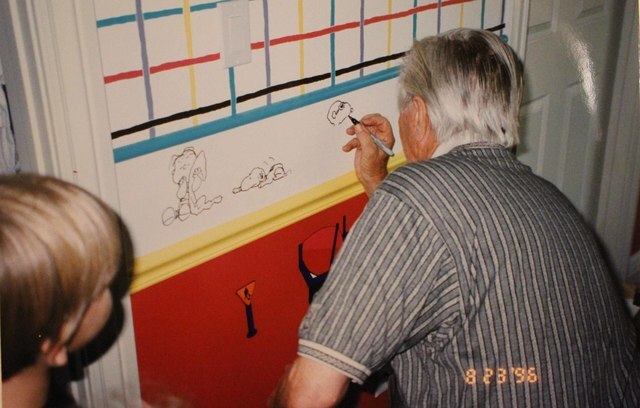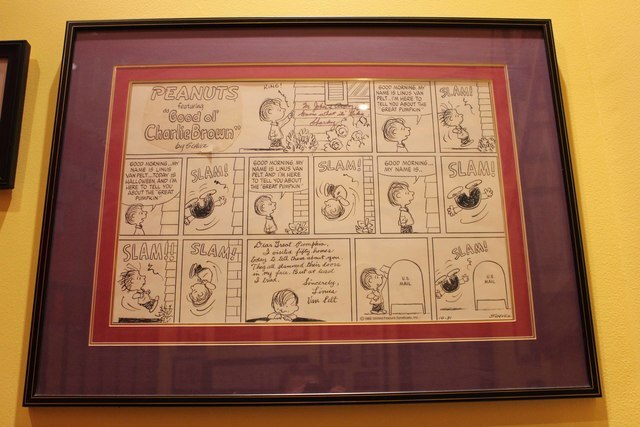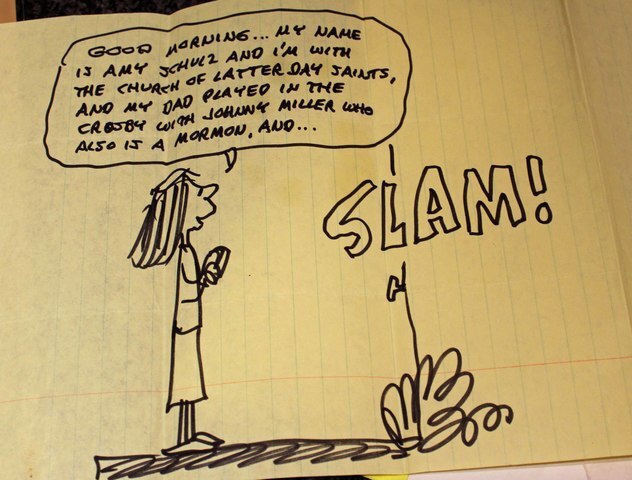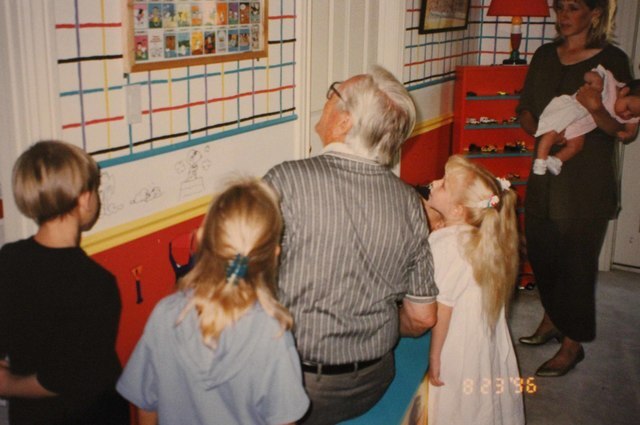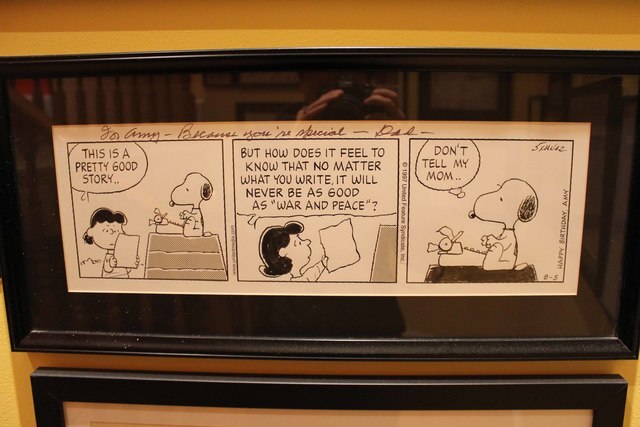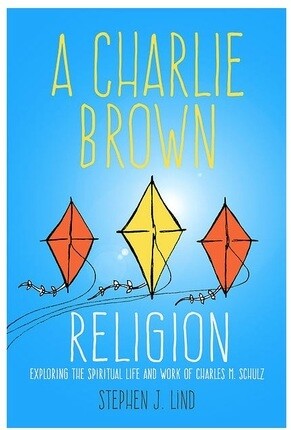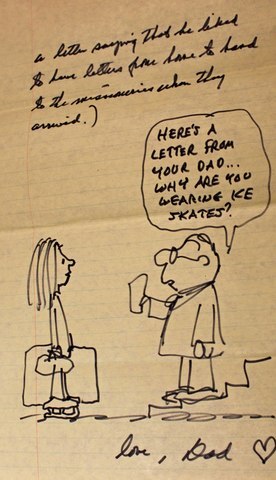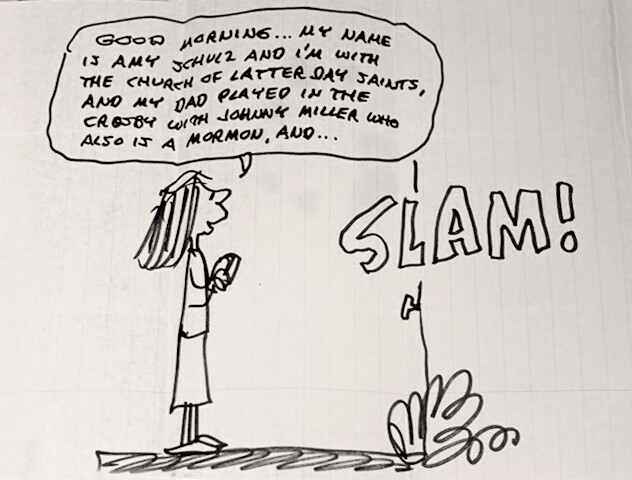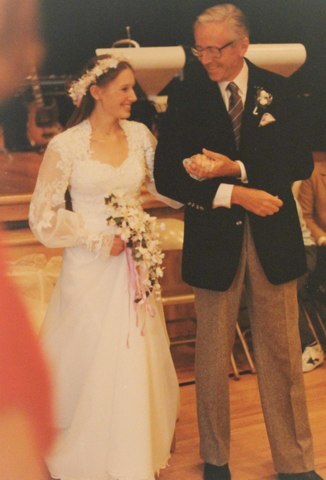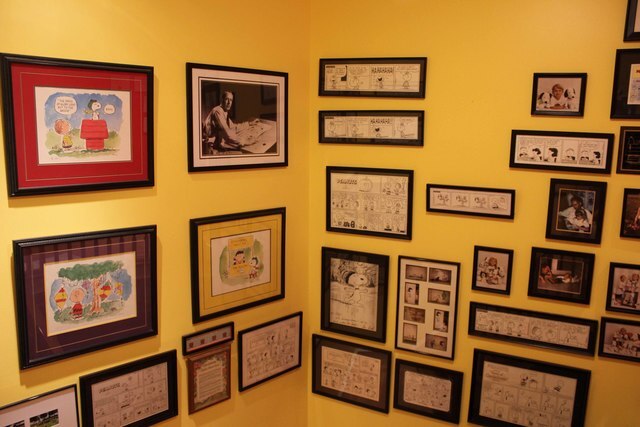This article originally ran in LDS Living in 2015. In celebration of the 70th anniversary of Charlie Brown's first mention in a comic strip on May 30, 1948, we wanted to share Charles M. Schulz's legacy of faith with our readers.
“There are three things that I’ve learned never to discuss with people,” says the endearing Peanuts character Linus Van Pelt. “Religion, politics, and the Great Pumpkin.”
In classic Peanuts style, this quote shows a maturity and insight beyond Linus’ limited years, speaking of a truth its creator, Charles M. Schulz, knew from experience.
“He always said, ‘If you want to know me, read my strip,’” Amy Schulz Johnson says, speaking of her father, Charles Schulz. “You could tell the things he believed in by reading Peanuts.”
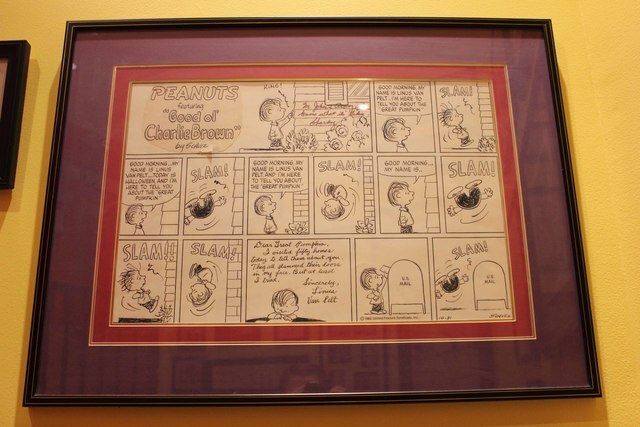
Comic strip hanging in Amy Schulz Johnson's home, one her father created for her after hearing of the difficulties she had on her mission with people slamming doors in her face.
Yet, many fans and critics of Schulz’s work disagree on his religious views, labeling him as everything from a fundamentalist Christian to an atheist. But those closest to Schulz and his work understand that, though complex and highly personal, his faith and belief in the Savior fueled every decision in his life. In fact, it was this deeply ingrained personal conviction that led him to go against Linus’ wise counsel and share his beliefs across the nation through the characters in his comic strip.
A Man of Faith in Action
“Throughout my entire life, I have seen my dad’s faith in action,” Johnson says. “I remember there was a big yellow chair in our old house, and every day he used to sit there and read scriptures.”
And though not a Methodist or member of any other organized religion, Johnson recalls that “every Sunday he taught Sunday School at a Methodist church at our little town in northern California for 12 years.”
While a witness to his example, Johnson admits that her father was very private about his faith and beliefs. They were something he lived, not something he openly shared, preached, expected his children to live.
And therein lies the paradox of this great man, who held his beliefs so close and private, yet dared through his work to spread messages of hope, values, grace, and even Jesus Christ publicly, in a profession that usually ridiculed such things.
“He wasn’t afraid to put his faith in Peanuts,” Johnson says. “He felt that his characters were serious enough to be able to have things like scriptures in the strip. He never liked it when people referred to the strip as ‘just for kids’ just because it was little kids voicing the feelings and ideas—but the strip was not for children, it was more for adults. He was really proud of that.”
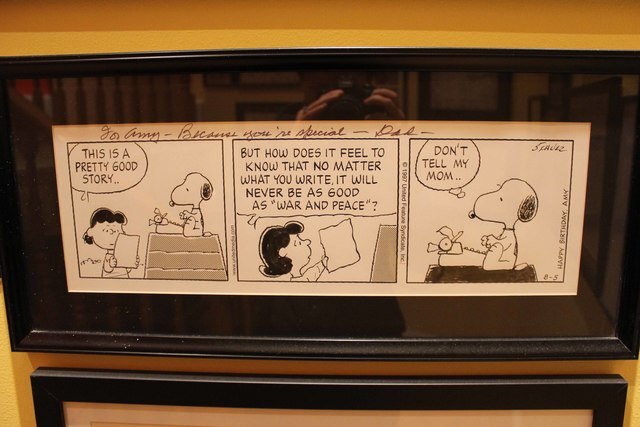
Comic strip hanging in Amy Schulz Johnson's home with a personal note that reads "To Amy—because you're special—Dad."
Using the innocent voices of children, Charles Schulz taught readers of all ages across decades about the fundamentals of life—about family, failure, education, imagination, and so much more.
“There are lots of kids out there living terrible lives, where literally the only thing that saved them was the Peanuts comic strips,” Johnson says. “It’s amazing; their stories are incredible.”
Schulz’s most stirring demonstration of faith came in the form of A Charlie Brown Christmas, a short animated television special that debuted on December 9, 1965. In the special, there’s a moment when Linus tells Charlie Brown what Christmas is really all about, quoting the story from Luke 2:8-14—a moment that generated a lot of controversy at the time.
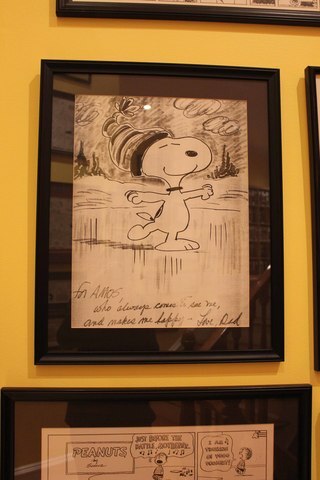
Drawing of Snoopy hanging in Amy Schulz Johnson's home, one her dad personally created and signed for her because of her love of ice skating.
“His producer and director said, ‘You can’t do this,’ and he said, ‘If we don’t do it, who will?’” Johnson recalls. “So they put it in. They showed it to CBS that year, and all the bigwigs in Hollywood didn’t like it at all. They said, ‘We’ll air it. But you shouldn’t have those religious things in there, so it will only air this one year and that’s it.’”
That year, A Charlie Brown Christmas received high ratings from viewers and acclaim from critics. Since that time, it has been honored with an Emmy and Peabody Award and has aired on television every single year since its debut.
Learning About the Latter-day Saints
Charles Schulz’s faith and relationship to his daughter took on a new dimension after Johnson joined the LDS Church.
Johnson’s first draw to the Church came in the form of an LDS boyfriend, whom she would ask questions about his faith.
“He explained to me about things like the Word of Wisdom, that Mormons didn’t believe in drinking,” Johnson remembers. “I was stunned. I thought my family was the only one that lived like that and I never thought I’d find someone else who felt that way.”
Johnson was initially attracted to the Church more because of the lifestyle than the religion itself. Having not grown up with a specific religion, many of the ideas were new and strange to her. But even after breaking up with her boyfriend, Johnson continued investigating the Church.
“I stayed in the Church because the lifestyle reminded me of how I grew up,” she says. “But I essentially joined for myself, not my boyfriend. It matched perfectly with all the things I’d been taught.”
Though private in his own beliefs, Schulz made it clear to his daughter what he thought about this new church she was joining.
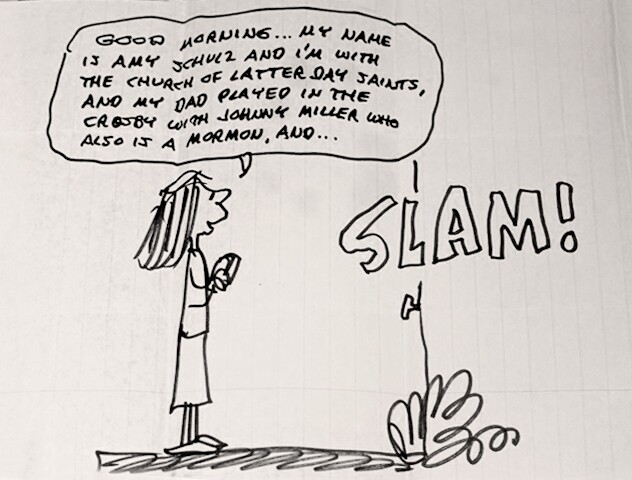
Letter and comic Charles M. Schulz sent to his daughter while she was serving her mission.
“I remember my dad said, ‘Your church is either true or it’s a hoax. And I think it’s a hoax,’” Johnson recalls. “I remember at the time thinking how profound that was, that he could put things so simply—just like he could put something that would normally take four paragraphs to explain into four simple frames in a comic.”
Years later, long after her father’s passing, Johnson heard these same words echoed over the pulpit at general conference. “Each of us has to face the matter—either the Church is true, or it is a fraud. There is no middle ground. It is the Church and kingdom of God, or it is nothing,” President Hinckley said in the April 2003 conference.
“I about fell off the couch,” Johnson recalls. “I had heard that before. It was a weird, eerie feeling. But I knew they were both right. The only difference between what my dad said and President Hinckley said was that President Hinckley knew the truth.”
Though disenchanted with the Mormon faith, Schulz never withheld his support from his daughter.
“He wrote me letters on my mission and he’d send me funny pictures of comics and Snoopy out tracting, stuff like that,” Johnson says. “He stood outside the temple and waited for me when it was freezing and soggy. He spoke at my mission farewell. He was just there for me every step of the way.”
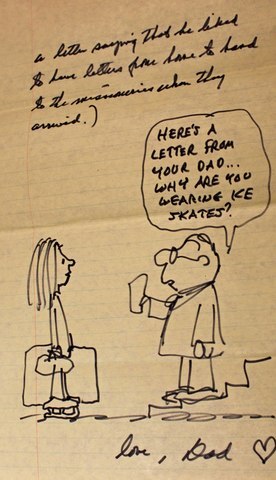
Letter and comic Charles M. Schulz sent to his daughter while she was serving her mission.
In many of his letters and conversations with his daughter, Charles Schulz was sure to share his praise and love. “He told me, ‘I’m so proud of you. I tell everyone about you and how you’re working hard for the Lord,’” Johnson says.
“Many of the letters I received from him on my mission were filled with scriptures and advice, telling me how God knows my heart,” she continues. “He just wrote beautiful things. The only Christmas I was gone, he said, ‘Don’t be sad that we’re away from each other; let us rejoice in our love of Christ.’”
Once back from her mission, Johnson’s close relationship with her father continued to grow and develop. “And as things grew, and as time went on, I would want to tell him more about the Church, and I would always start with, ‘I know how much you hate the Church, but . . .' Finally, one day he said, ‘Would you stop saying that? I don’t hate the Church, but I love how we have this bond now where we both believe in Christ and the scriptures.’”
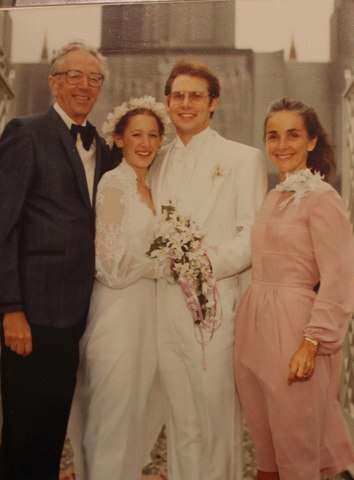
Charles M. Schulz outside the temple on his daughter's wedding day.
A Man with a Living Legacy
Charles M. Schulz, or Sparky, as he was known to his friends, died on February 12, 2000, of colon cancer.
“My brother once asked if I was afraid of our parents dying,” Johnson remembers. “I said, 'Not dying. I’m afraid that dad will outlive his ability to draw the comic strip.’ Because that’s all he ever wanted to do; he never wanted to retire from that. He just wanted to draw.”
A master of concision and timing, Charles Schulz’s exit from this life was as impeccably timed as his Peanuts strips. Knowing of his diagnosis and the battle ahead, Schulz had created a farewell comic strip for his readers that was set to run February 13, 2000. In it, he wrote, “Dear Friends, I have been fortunate to draw Charlie Brown and his friends for almost 50 years [. . .] Unfortunately, I am no longer able to maintain the schedule demanded by a daily comic strip. [. . .]therefore I am announcing my retirement. I have been grateful over the years for the loyalty of our editors and the wonderful support and love expressed to me by fans of the comic strip. Charlie Brown, Snoopy, Linus, Lucy…how can I ever forget them.”
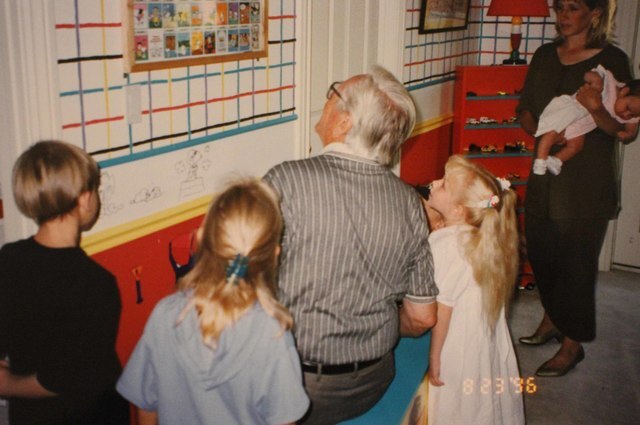
Charles M. Schulz sprucing up his grandkids' walls with drawings of Linus and Snoopy.
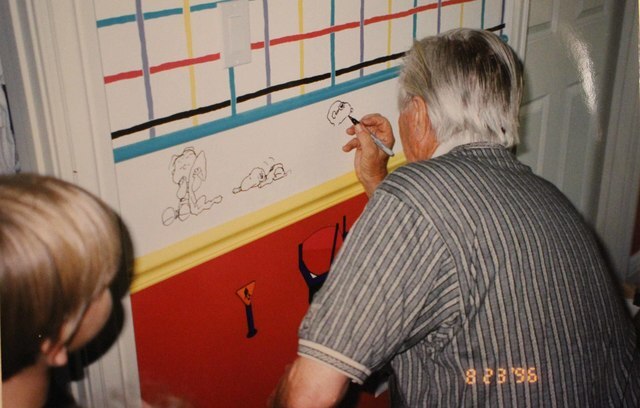
Charles M. Schulz sprucing up his grandkids' walls with drawings of Linus and Snoopy.
About his death Johnson recalls, “He wasn’t sick enough to die that night; he’d been cleared by all his doctors. . . . It was almost as if he just snuck out.”
Schulz died at 9:45 p.m. in his home in California—around 12:45 a.m. on February 13 in New York. “When you think about the time difference between here and New York, they were just beginning to print the paper for the next day as my dad was dying. How strange is that?”
For his funeral, Johnson was tasked with giving one of the memorials—of summing up the life of this incredibly strong and complex man in a mere three minutes—a daunting if not impossible task.
But then Johnson recalled something her father had told her nearly a decade ago—something that then had seemed incidental, but that now seemed to carry the legacy and meaning of her father’s work.
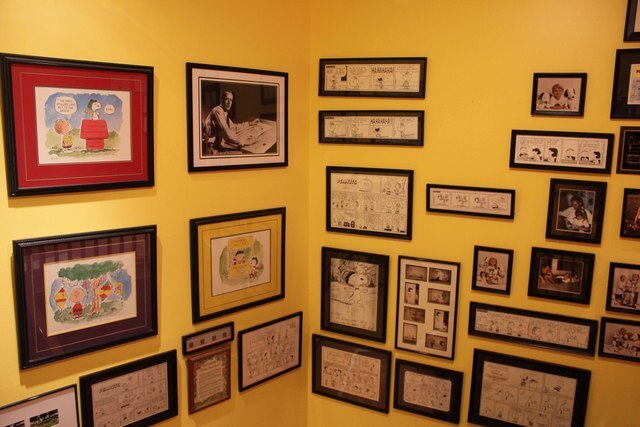
Comics hanging in the Johnson home, commemorating the life and legacy of Charles M. Schulz.
“We were just talking about stuff and he said to me, ‘Americans want decency. They want decent entertainment. And I’ve always believed that. I always felt that if I ever did anything crude or raunchy, that God would literally strike the fingers off my hand.’ This is the man people say didn’t believe in God! . . .
"Think about if every single person in any form of entertainment believed that—that if they ever did anything crude or raunchy, God would strike the fingers off their hand? That’s a pretty big way to lay down the pen each morning!”
Though it might be a big measuring stick for many in the media business to live up to, it was a standard Charles M. Schulz lived in his day-to-day life and one he embodied in his work. Because, as Johnson notes, “my dad knew from where his talent came,” and he stayed true to the source of his faith and his talent.
All images courtesy of Amy Schulz Johnson and her family.
Charles M. Schulz's Peanuts comic strip franchise, the most successful of all time, forever changed the industry. For more than half a century, the endearing, witty insights brought to life by Charlie Brown, Snoopy, Linus, and Lucy have caused newspaper readers and television viewers across the globe to laugh, sigh, gasp, and ponder. A Charlie Brown Religion explores one of the most provocative topics Schulz broached in his heartwarming work—religion.

